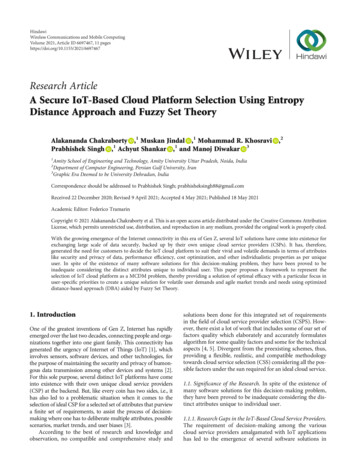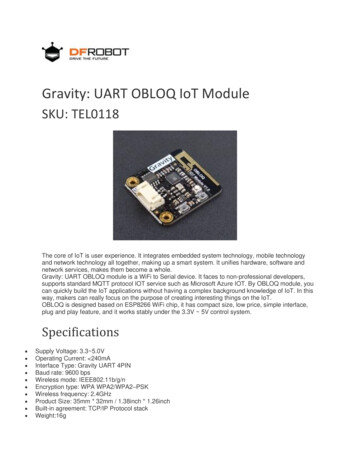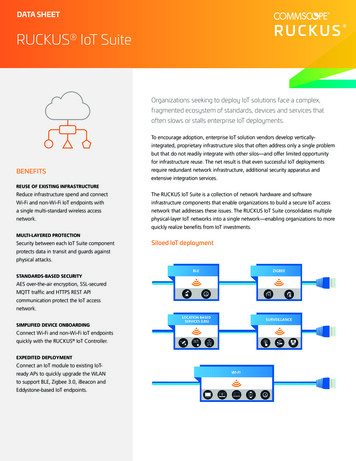
Transcription
DATA MODELING FOR IOTAPACHECON IOT NORTH AMERICA 20171 2016, Conversant, LLC. All rights reserved.PRESENTED BY:JAYESH THAKRARSENIOR SOFTWARE ENGINEER
WHY DATA MODELING FOR IOT?1. IoT is the next big wave after social media(e.g. connected cars, smart homes & appliances)2. Interesting challenges of volume, velocity and variety3. Can be applied to other big data problems2
DATA MODELING FOR IOT1. Discuss sample IoT application2. Discuss data model3. Discuss application architecture3
SampleApplication4
INTELLIGENT VEHICLESCommunication Endpoints:Cloud (Internet)Road-sideinfrastructure5 V2V: Vehicle to Vehicle V2C : Vehicle to Cloud V2I: Vehicle to Infrastructure Event single, discretecommunication messageexchanged between a vehicleand infrastructure
V2I: DATA & APPLICATION ASSUMPTIONS 1 billion vehicles500 events per vehicle/day, based onavg. time on road 3 hours 180 min1 event per 10-30 seconds (avg 3 per min) 180*3 540 events/vehicle Avg. event size 250-500 bytesTotal raw data size 150-300 TB / dayCassandra datastorecan be applied to HBase or other similarlyscalable datastore with appropriate testing Streaming for ingestion/processing/ETLAdhoc and batched analytics, extraction, etcAvoid schema-level indexesfor maintainability, efficiency, size, storage, etc.6
SAMPLE APPLICATION ARCHITECTUREData storageIngestion pipelineStream processing and analytics7
DATA MODEL CONSTRAINTS / REQUIREMENTS Efficient, low-latency writes and reads Sample queries:- Events for a vehicle between two dates (or timestamps)- Events for an infrastructure between two dates (or timestamps)- Events by all infrastructure on a specific road-segment in a region Short, adhoc query characteristics/needs (guesstimate)- volume 100 – 100,000 rows- response time 100 ms – 100 seconds (proportional to result size)8
SCHEMA VISUALIZATION: STAR SCHEMATime / CalendarVehicleRegionEventRoad SegmentInfrastructure9
CAN ALSO BE APPLIED TO: ADVERTISING/SEARCHTime / CalendarCookieRegionEventLocationURL10
CN ALSO BE APPLIED TO : SOCIAL NETWORKSTime / CalendarUserRegionActionLocationPage11
IoT Data Model12
INSPIRATION: UNIX FILESYSTEM INODE13
CASSANDRA: TABLE BASICS Data stored in tables with pre-defined schema Data types: primitives, collections, user-defined type– Collections sets, maps, lists– Map keys and set and list values sorted Every table has primary key (PK)– PK single column or multi-column (composite)– Data distributed on cluster nodes based on hash of first part of PK14 Keyspace collection of (related) tables PK based queries very fastbecause of bloom filter, key cache, sstable indexes
DATA ASSUMPTIONS (SIMPLISTIC MODEL)15
TABLE SCHEMA OPTIONSTraditional table structure - column for each fieldINSERT INTO event(id, timestamp, vehicle id, infra id,.)INSERT INTO event JSON '{ "id" : 1234, "timestamp" : ".", .)All data fields serialized into a single columnINSERT INTO event(id, data)VALUES (1234, "JSON/blob/serialized avro/etc") // data blob or textAll data field stored into a collection field (e.g. map and/or set)INSERT INTO event(id, data)VALUES (1234, {'timestamp': .}) // data map text, text 16
STAR SCHEMA: DIMENSION TABLES17
STAR SCHEMA: EVENT NAVIGATION TABLES18
VEHICLE - EVENTS : VEH EVENTCREATE TABLE veh event(id TEXT PRIMARY KEY, map data MAP TEXT, TEXT , set data SET TEXT , .)vehicle id eb5071d8-0e35-4a82-ad37-543d3da66de7event id 25b6a3f4-5eec-4b04-954e-6d6bf85c4776Level 0: Map of pointers to hourly data for each vehicleeb5071d8-0e35-4a82-ad37-543d3da66de7set data: (2017062408, 2017062409, .)Level 1: Map of pointers to actual event data for a vehicle for a given hour intervaleb5071d8-0e35-4a82-ad37-543d3da66de7, 2017062408Actual event data25b6a3f4-5eec-4b04-954e-6d6bf85c477619data : .map data: (08:23:16.732 - 25b6a3f4-5eec-4b04-954e-6d6bf85c4776, .)
INFRASTRUCTURE - EVENTS: INFRA EVENTCREATE TABLE infra event(id text PRIMARY KEY, map data MAP TEXT, TEXT , set data SET TEXT , .)infra id ffe0bdbb-3b89-4337-a477-4a17f719b559vehicle id eb5071d8-0e35-4a82-ad37-543d3da66de7event id 25b6a3f4-5eec-4b04-954e-6d6bf85c4776Level 0: Map of pointers to hourly data for each infrastructureL0, ffe0bdbb-3b89-4337-a477-4a17f719b559set data: (2017062408, 2017062409, .)Level 1: Map of pointers to actual event data by vehicle for an infrastructure for a given hour intervalL1, ffe0bdbb-3b89-4337-a477-4a17f719b559, 2017062408 map data: (23:16.732, eb5071d8-0e35-4a82-ad37-543d3da66de7 - 25b6a3f4-5eec-4b04-954e-6d6bf85c4776, .)Actual event data25b6a3f4-5eec-4b04-954e-6d6bf85c477620data : .
LOCATION - EVENTS: LOC INFRA EVENTCREATE TABLE loc infra event(id text PRIMARY KEY, map data MAP TEXT, TEXT , set data SET TEXT , .)region id 3aa40699-357e-48db-888b-af2ff7856949road seg id 60b57655-0670-4969-9eec-99bcf8c8a034infra id ffe0bdbb-3b89-4337-a477-4a17f719b559Level 0: Map of pointers to road-segments by region3aa40699-357e-48db-888b-af2ff7856949set data: (60b57655-0670-4969-9eec-99bcf8c8a034, .)Level 1: Map of pointers to infrastructure by t data: (ffe0bdbb-3b89-4337-a477-4a17f719b559, .)map data can be used above if there is a need to store any data (e.g. timestamp) along with road-segment or infra id21
LOGICAL & PHYSICAL DESIGN CONSIDERATIONS Split each "level" of (logical) event navigation table into physical tables– Primary keys for tables – combine process-level UUID counter E.g.–– Immutable event level data (insert-only into event and navigation tables)TTL to "age-out/purge" old dataKeyspace sharding by time period and Cassandra compaction strategy–22CREATE TABLE vehicle event(id BLOB PRIMARY KEY, m MAP TEXT, TEXT , s SET TEXT , .)Compact data e.g. time-of-day timestamps as integer i.e. ms of the day)Data immutability (helps reduce Cassandra entropy & ghost data concerns)–– uuid - NNNN (reduces number of UUID generation calls)Further compact primary key by using binary encoding instead of string(e.g 16 bytes for UUID 8 bytes for counter)Short column names and appropriate data formats–– E.g. vehicle event into vehicle event lo, vehicle event l1Allows tuning parameters like cache, partition size, bloom filter as well as maintenance, etc.Keyspace by day/hourCompaction strategies - LCS, STCS and DTCS/TWCS
KEY TAKEAWAYS OF DATA MODEL Single column primary keys Short primary key and column names All access (single row or range scan) via primary keys only Range scan (when necessary) appropriately paginated Immutable data (no updates/deletes) and idempotent inserts Data purge (TTL v/s keyspace by time period)23
The Big PictureData Architecture App Architecture24
SINGLE CLUSTER, CENTRALIZED INGESTION & PROCESSINGSingle, centralized Cassandra cluster withdata-pipeline from different locations25
MULTI-DATACENTER CLUSTER, INGESTION & PROCESSING26
MULTIPLE INDEPENDENT, MODULAR SYSTEMSMultiple, independent Cassandra clusters at differentdatacenters along with an optional central clustercontaining select and/or aggregated data.27
Reference & Misc28
SAMPLE OF V2I REFERENCE INFORMATION29 https://www.its.dot.gov/index.htm https://www.its.dot.gov/v2i/ https://www.its.dot.gov/communications/media/15cv future.htm https://www.iso.org/committee/54706/x/catalogue/ https://www.iso.org/standard/69897.html
SCALA SAMPLE TO MAP SET DATA INTOINDIVIDUAL CASSANDRA ROW ACCESScase class Data(key: String, values: Set[String]) extendsIterator[Tuple2[String, String]] {private val i values.iteratordef hasNext i.hasNextdef next Tuple2[String, String](key, i.next)}val d Seq[(String, Set[String])](("a",Set[String]("a-1", "a-2", "a-3")))scala d.flatMap(i Data(i. 1, i. 2))res3: Seq[(String, String)] List((a,a-1), (a,a-2), (a,a-3))30
31
DATA MODELING FOR IOT APACHECON IOT NORTH AMERICA 2017 PRESENTED BY: JAYESH THAKRAR SENIOR SOFTWARE ENGINEER. 2 WHY DATA MODELING FOR IOT? 1. IoT is the next big wave after social media . Keyspace sharding by time period and Cassandra compaction strategy - Keyspace by day/hour Compaction strategies - LCS, STCS and DTCS/TWCS. 23 KEY .










